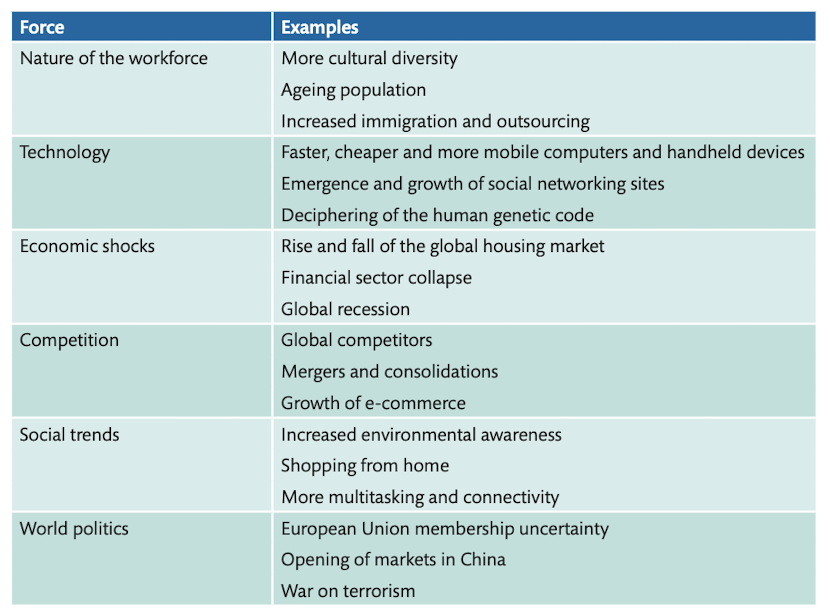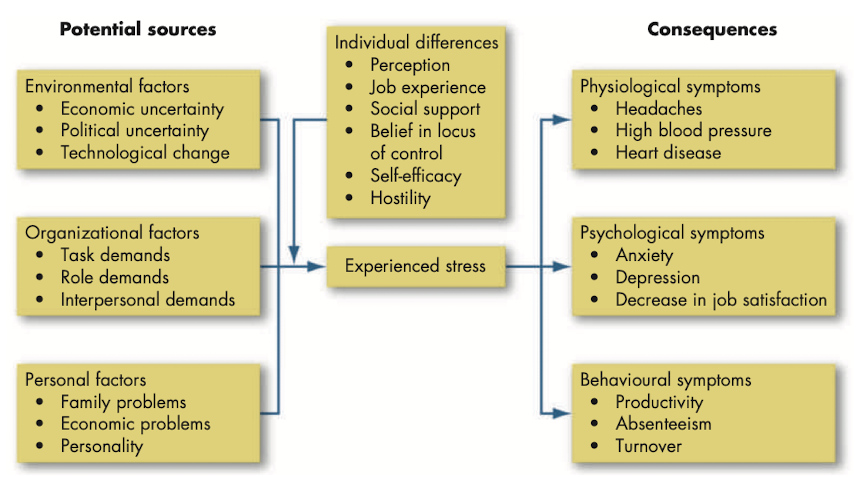Chapter 18 - Organizational change & stress management
Forces for change

Planned change
- @@Change@@: making things different.
- @@Planned change@@: change activities that are intentional and goal-oriented.
Resistance to change
@@Change agents@@: persons who act as catalysts and assume the responsibility for managing change activities.

Approaches to managing organizational change
Lewin’s three-step model
- @@Unfreezing@@: changing to overcome the pressures of both individual resistance and group conformity.
- @@Movement@@: change process that transforms the organization from the status quo to a desired end state.
- @@Refreezing@@: stabilizing a change intervention by balancing driving and restraining forces.
- Driving forces: forces that direct behavior away from the status quo.
- Restraining forces: forces that hinder movement from the existing equilibrium.
Kotter’s eight-step plan for implementing change
- Establish a sense of urgency by creating a compelling reason for why change is needed.
- Form a coalition with enough power to lead the change.
- Create a new vision to direct the change and strategies for achieving the vision.
- Communicate the vision throughout the organization.
- Empower others to act on the vision by removing barriers to change and encouraging risk taking and creative problem solving.
- Plan for, create and reward short-term “wins” that move the organization towards the new vision.
- Consolidate improvements, reassess changes and make necessary adjustments in the new programs.
- Reinforce the changes by demonstrating the relationship between new behaviors and organizational success.
@@Action research@@: change process based on systematic collection of data and then selection of a change action based on what the analyzed data indicate.
@@Organizational development (OD)@@: collection of planned change interventions, built on humanistic democratic values, that seeks to improve organizational effectiveness and employee well-being.
@@Sensitivity training@@: training groups that seek to change behavior through unstructured group interaction.
@@Survey feedback@@: use of questionnaires to identify discrepancies among member perceptions; discussion follows and remedies are suggested.
@@Process consultation (PC)@@: meeting in which a consultant assists a client in understanding process events with which he/she must deal and identifying processes that need improvement.
@@Team building@@: high interaction among team members to increase trust and openness.
@@Inter-group development@@: OD efforts to change the attitudes, stereotypes and perceptions that groups have of each other.
@@Appreciative inquiry (AI)@@: approach that seeks to identify the unique qualities and special strengths of an organization, which can then be built on to improve performance.
Creating a culture for change
- Stimulating a culture of innovation
- @@Innovation@@: new idea applied to initiating or improving a product, process or service.
- @@Idea champions@@: individuals who take an innovation and actively and enthusiastically promote the idea, build support, overcome resistance and ensure that the idea is implemented.
- Creating a learning organization
- @@Learning organization@@: organization that has developed the continuous capacity to adapt and change.
- @@Single-loop learning@@: process of correcting errors using past routines and present policies.
- @@Double-loop learning@@: process of correcting errors by modifying the organization’s objectives, policies and standard routines.
Work stress and its management
@@Stress@@: unpleasant psychological process that occurs in response to environmental pressures.
@@Challenge stressors@@: stressors associated with work load, pressure to complete tasks and time urgency.
@@Hindrance stressors@@: stressors that keep you from reaching your goals (red tape, office politics, confusion over job responsibilities).
@@Demands@@: responsibilities, pressures, obligations and even uncertainties that individuals face in the workplace.
@@Resources@@: things within an individual's control that can be used to resolve demands.
